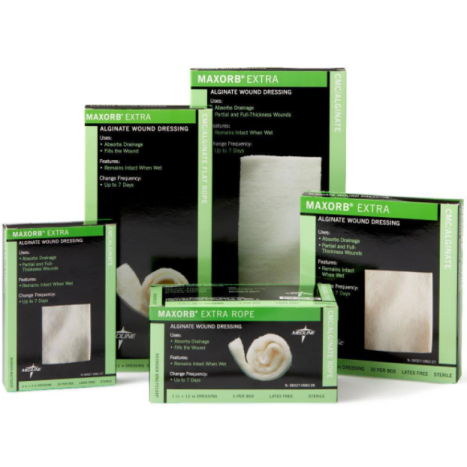The Maxorb Extra CMC/Alginate Wound Dressing Advantage
This product retains its strength, even when it is saturated. This means it is easy to remove in a single piece and that there is a reduced chance of residual dressing material being left behind in the wound bed upon its removal. This dressing comes in several sheet sizes and both sheet and rope versions are available. Medline Maxorb Extra CMC/Alginate Sheet Wound Dressings are a great option for surface wounds, while rope dressings are suited for cavity wounds. These products can be cut to the size of the wound for a better fit.
Patients interested in this product may also be interested in Maxorb Extra Ag Plus Silver Antimicrobial Dressings. This alternative version combines alginate and CMC technology with the antimicrobial and odor reducing effects of real silver.
What is Maxorb Extra Used for?
This product is indicated for the following wound types:
- 1st and 2nd Degree Burns
- Abrasions
- Cavity Wounds
- Diabetic Ulcers
- Donor Sites
- Full-Thickness Wounds
- Lacerations
- Leg Ulcers
- Partial-Thickness Wounds
- Pressure Ulcers
- Surgical Wounds
Features and Benefits
- Highly Absorbent
- Maintains Moderate to Heavy Discharge
- Outperforms Other Alginate Dressings
- Wound-Conforming
- Maintains a Moist Wound Environment
- Gel-Forming
- Uniform Fluid Retention
- CMC Improves Gelling and Fluid Handling
- Maceration Preventative Design
- Strong, Even When Saturated
- Single-Piece Removal
- Easy Dressing Changes
- Can Be Cut-to-Fit
- Sheets and Ropes Available
- Great for a Variety of Wound Types
- Can Be Used on Infected Wounds
- Latex-Free
- Single-Use Only
Maxorb Extra Complementary Products
Recommended Secondary Dressings
- Bordered Gauze: A water-resistant gauze dressing with an adhesive order.
- Optifoam Gentle Border Dressing: A highly absorbent foam dressing with a gentle silicone border.
- Stratasorb Composite Dressing: A four-layer, waterproof, absorbant dressing with nonwoven backing and an adhesive border.
Other Products
- Piston Irrigation Syringe: A 60 cc, catheter tipped syringe that can be filled with saline or another wound cleansing solution for wound irrigation.
- McKesson USP Normal Saline Solution: A 0.9% Sodium Chloride saline solution for wound cleansing. It can be used to irrigate the wound and help remove alginate dressings if they stick to the wound bed and become difficult to remove.
- Vashe Cleansing Solution: A no-sting, prescription-strength skin, wound, and burn cleanser and wound debrider that can be used on a wide variety of wound types.
Maxorb Extra CMC/Alginate Dressing Use and Safety
Contraindications
- Alginate allergy or sensitivity
- A dry wound bed
- 3rd degree burns
- Use as a surgical sponge
Frequently Asked Questions
Is Maxorb the same as calcium alginate?
Maxorb is made from a combination of calcium alginate and sodium carboxymethylcellulose fibers.
What is alginate dressing made of?
Alginate wound dressings are made from the natural, biodegradable ingredient seaweed. These seaweed sheets help prevent infection and absorb large amounts of wound discharge.
Is carboxymethylcellulose toxic?
Carboxymethylcellulose is non-toxic and non-allergenic.
What does carboxymethylcellulose do?
Carboxymethylcellulose is a derivative of cellulose. It is sometimes used in wound care to help create a gel that retains moisture and maintain a moist environment to hasten healing. In addition, CMC has been shown to encourage granulation tissue growth and make scarring less likely.
How to Apply Maxorb Extra Alginate Wound Dressing
- Store this item stored at room temperature before use.
- Read all packaging directions and safety guidelines.
- Use a sterile saline solution to clean and irrigate the wound bed.
- Remove the dressing from its packaging and dispose of the packaging.
- Loosely fill the wound bed.
- Apply an appropriate secondary dressing.
How Often Should Maxorb Extra Be Changed?
This dressing should be changed at least every seven days. Change frequency will, however, depend on the amount of wound exudate and a doctor's recommendation.
Ingredients
Nonwoven alginate, carboxymethylcellulose.
Warning
- Do not use this product if the package is damaged.
- Do not store in excessive heat or freezing temperatures.
- Never re-sterilize or reuse this product. It is for single use only.
Manuals and Documents
 Safety Data Sheet contains safety and hazard information.
Safety Data Sheet contains safety and hazard information.
Product Videos
This Is Medline (2:36 minutes)
Product Specifications
- Manufacturer: Medline
- Item Numbers: MSC7012EP, MSC7022EPZ, MSC7044EP, MSC7044EPZ, MSC7048EP
- Application: Wound Care
- Type: Primary Dressing
- Absorbency: Moderate to Heavy
- Styles: Rope, Sheets
- Wound Types: Shallow to Deep
- Material: Non-Woven Alginate, Carboxymethylcellulose
- Color: White
- Sheet Sizes: 2 x 2 Inch, 4 x 4 Inch, 4 x 8 Inch
- Rope Length: 12 Inch
- Latex-Free: Yes
Sources
 Poulami Basu, et al. Characterization and Evaluation of Carboxymethyl Cellulose-Based Films for Healing of Full-Thickness Wounds in Normal and Diabetic Rats. 2018.
Poulami Basu, et al. Characterization and Evaluation of Carboxymethyl Cellulose-Based Films for Healing of Full-Thickness Wounds in Normal and Diabetic Rats. 2018.
 National Cancer Institute. Sodium Carboxymethylcellulose Dressing.
National Cancer Institute. Sodium Carboxymethylcellulose Dressing.
 Wound Source. What is an Alginate Dressing?.
Wound Source. What is an Alginate Dressing?.



Login and Registration Form